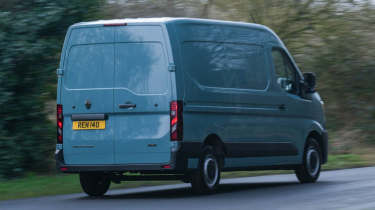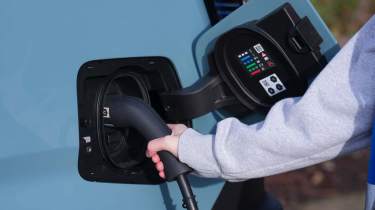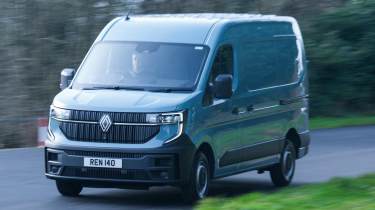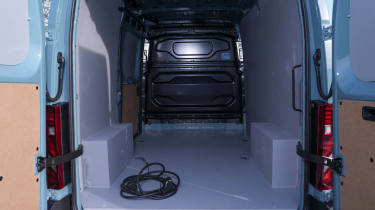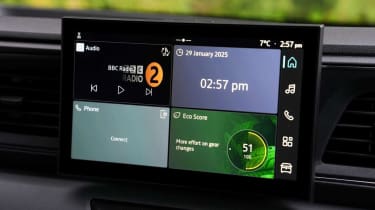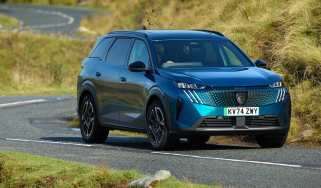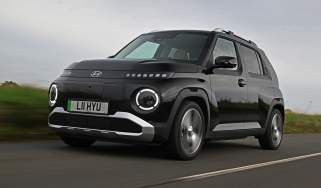Renault Master E-Tech review
The Master E-Tech stands out with its sharp styling, good tech and excellent EV range
Pros
- Long range
- Excellent cargo space and payload
- Drives well
Cons
- EV charging could be faster
- Limited panel van versions
- Performance is just average
| Range | Wallbox charge time | Rapid charge time |
| 285 miles | 13hrs 54mins (7.4kw) | 38mins (15-80%, 130kW) |
Renault Master E-Tech verdict
If you’ve stopped short of taking the plunge with an electric van in the past, the Renault Master E-Tech could well change your mind. With a long electric driving range and excellent payload, it’s a good alternative to diesel power. Plus, it’s well priced, offers excellent tech and comfort, and drives well. The Master E-Tech is a new high watermark for electric vans.
Details, specs and alternatives
You could say Renault is a master of electric vans. It has been building them for years, and while its earlier offerings (badged ZE) were decent enough, they were hamstrung by limited developments in battery technology.
Now, though, just like in the world of cars, electric tech is developing at a rapid pace. And, seemingly with every passing month, another electric van arrives, with the big players such as Ford, Mercedes and Stellantis-owned Peugeot, Citroen, Fiat and Vauxhall all producing EV versions of its most recognisable models.
Renault, along with its ‘alliance’ partner Nissan, believes that with its past experience of building electric vans, it can leap ahead of those rival brands with the new Master (and sister Nissan Interstar). While it may look similar to earlier models, it’s a totally new, ground-up design that focuses even more on cargo space, driver comfort, technology, and offering a strong electric driving range.
And that range is really impressive. Renault claims the Master can travel up to 285 miles after a full charge, which is comfortably ahead of the latest Ford E-Transit’s 249-mile maximum, the Citroen e-Relay’s 261-mile range, and the Mercedes eSprinter’s 273 miles. That’s even more impressive when you realise that the Master gets that range from a smaller battery pack than those rivals – it’s ‘just’ 87kWh and comes with 130kW DC charging capability.
Renault has been very clever by fitting a smaller battery than its rivals. Here, smaller equals lighter, so the Master E-Tech has a low total weight, which allows for a higher payload capacity than other electric vans. The 3.5-tonne Master E-Tech is capable of carrying up to 1,125kg, while the 4.0-tonne version manages up to 1,625kg. A 3.5-tonne Mercedes eSprinter can only carry a 774kg payload.
Compared with the previous Master, this fourth-generation version is larger in the rear – 100mm longer, to be precise, while the sliding-door opening is 40mm wider. The load area length is 3,225mm in the L2 model and 3,855mm in the L3, and cargo volumes are between 10.8m3 and 13.0m3 – that's more than the Ford E-Transit or Mercedes eSprinter, but doesn't better some Stellantis vans, such as the Vauxhall Movano Electric.
The Master E-Tech only comes in a single Advance specification, which includes LED headlights and bold C-shaped LED daytime running lights, manual air-conditioning, a 10-inch touchscreen with a Google-based operating system, Apple CarPlay and Android Auto, a seven-inch digital driver's display, plus a whole host of safety equipment, including blind-spot warning.
Prices start at £46,755 with the Government's Plug-in Van Grant and VAT included (£42,500 excluding VAT), which means the Master significantly undercuts the Ford E-Transit, Vauxhall Movano Electric and Maxus eDeliver 9, which all start at around £50,000. The Mercedes eSprinter is even pricier, at nearly £60,000.
Range, battery size & charging
| Model | Range | Wallbox charge time | Rapid charge |
| Renault Master E-Tech MM35 (L2H2) | 255 miles | 13hrs 54mins (7.4kw) | 38mins (15-80%, 130kW) |
| Renault Master E-Tech MM40 (L2H2) | 285 miles | 13hrs 54mins (7.4kw) | 38mins (15-80%, 130kW) |
| Renault Master E-Tech LM35 (L3H2) | 255 miles | 13hrs 54mins (7.4kw) | 38mins (15-80%, 130kW) |
| Renault Master E-Tech LM40 (L3H2) | 285 miles | 13hrs 54mins (7.4kw) | 38mins (15-80%, 130kW) |
Buy a Renault Master E-Tech in another European market, and you'll have the choice of 40kWh and 87kWh battery packs. Indeed, the Master's sister van, the Nissan Interstar, can be ordered with either pack in the UK. But Renault believes Brits will prefer the larger one, so it's only offering the 87kWh battery.
The larger battery pack gives Renault bragging rights over its competitors, because with a range of up to 285 miles, it puts the Master right up there with the best in the class. It's pretty impressive that Renault has managed this considering that the 87kWh pack is smaller than rivals' offerings, but it's thanks to the Master's more aerodynamically efficient bodywork. It's the heavier 4.0-tonne model which achieves that impressive 285-mile figure, though, thanks to having a speed limiter, while the 3.5-tonne version makes do with 255 miles.
Both versions get 130kW DC charging capability, Vehicle-to-Grid (which allows you to send power back into the network), and Vehicle-to-Load, which lets you charge up other electrical items using the battery, which will be ideal for tradespeople who need to power tools.
Renault doesn’t offer a heat pump, but the Master has a unique battery thermal management system that the firm claims is more efficient. Also, the battery pack is made up of 12 separate modules so they can be removed, repaired or replaced individually. Renault says this makes it easier and cheaper to fix issues.
Running costs & insurance
During our test of the N1 (L2H2) 3.5-tonne version, we achieved a hugely impressive three miles per kWh, which equates to a higher-than-claimed 261 miles. That was with two people on board, the air-conditioning on, and over a variety of roads, but crucially without a load in the back. Another test with a 400kg payload yielded a 250-mile range, so the Master E-Tech is an efficient electric van.
The Master E-Tech needs a service in the first year or after 12,000 miles, but from then onwards it's every two years or 24,000 miles.
Performance, motor & drive
| 0-62mph | Top speed | Driven wheels | Power |
| N/A | 75mph | Front | 138bhp |
Renault has worked very hard to make this new generation of Master very refined. The diesel versions are remarkably quiet and smooth, and the electric E-Tech just ups the ante.
Power comes from a 138bhp, 300Nm electric motor that drives the front wheels, meaning that on paper it is no quicker than the diesel variants. In the real world, even unladen, the E-Tech isn't a quick van and feels decidedly less sprightly than a Ford E-Transit. But it's punchy enough around town and its performance will be more than adequate enough for the majority of drivers.
The steering is light and accurate, while there's a reassuring solidity to the brakes, but the real highlight is the ride. The Master E-Tech is very comfortable, even over pot-holed roads, and it doesn't rattle and shake over the worst road imperfections.
There are no multiple settings for regenerative braking, just a 'B' mode on the gear selector giving maximum regen. Select it and take your foot off the throttle, and it slows down fiercely and gives near one-pedal driving. It's a shame there's no adjustability here, though.
The Master E-Tech gets a similar raft of safety equipment as Renault's passenger cars, with features such as speed limit warning with road sign detection and lane-keep assist coming as standard. The speed warning and lane-keep assist can be easily programmed to be switched off via the 'MyPerso' drive mode setting, and requires just two prods of a button on the dashboard. It's a refreshingly easy and simple solution that’s also found on the brand’s cars.
Interior, dashboard & infotainment
The interior of the latest Master is a huge improvement on the previous version, because it boasts more space, tech and comfort. There’s a real car-like feeling once you’ve climbed (and you really do climb up into the Master) into the driver’s seat, with an S-shaped dashboard.
Renault only offers the E-Tech in entry-level Advance trim, but it still gets an impressive list of kit, including a large 10-inch infotainment system. It’s the type of set-up you’ll find in one of Renault’s cars, with crisp graphics and a slick Google-based operating system. The E-Tech comes as standard with a digital driver’s display, while the climate-control dials are big and sturdy, and sit above a large wireless smartphone charging pad.
There’s seating for three people, and the seats are extremely comfortable for long trips. There is plenty of adjustment in the steering column, and visibility is excellent – helped by a pair of large door mirrors. There are 135 litres of cabin storage, including overhead shelves, large bins overhead and a big space under the middle seat. This seat can also be folded down to create a handy desk area, with USB-C ports to keep devices topped up.
There are only two cup-holders, one on either side of the dash, which also serve as handles to aid entry and exit, because there are no traditional grab handles. There is also a manual handbrake, something which will be appreciated by drivers but is unusual in 2025; although Renault says it will be introducing an electronic handbrake later in the year.
Boot space, seating & practicality
| Model | Length | Width | Height | Load space length | Load space width | Load space height | Load space volume |
| L2H2 | 5,680mm | 2,080mm | 2,502mm | 3,225mm | 1,537mm | 1,885mm | 10.8m3 |
| L3H2 | 6,315mm | 2,080mm | 2,502mm | 3,855mm | 1,537mm | 1,885mm | 13.0m3 |
The UK gets just two sizes of Renault Master E-Tech – an L2H2 and a L3H2 – which means load volumes of either 10.8m3 and 13.0m3. While that offering is limited it's good for the class, with both vans having larger cargo volumes than a like-for-like Ford E-Transit or Mercedes eSprinter. The load area is 100mm longer than before, and the more upright bulkhead makes it easier for boxes to be stacked against it.
The Master comes out on top for payloads, thanks to that smaller 87kWh battery pack compared with rivals. The 3.5-tonne Master E-Tech is capable of carrying up to 1,125kg, while the 4.0-tonne version manages up to 1,625kg. By comparison, a 3.5-tonne Mercedes eSprinter can only carry a 774kg payload.
The sliding-door opening area is the widest in the class, at 1,312mm (40mm wider than before, and there are twin rear doors, which each open 270 degrees.
Reliability & safety rating
The Master E-Tech is such a new van that it's hard to give a view on reliability. However, the previous Master E-Tech had a good reputation for being reliable, so there's an expectation that this new one will be dependable for owners.
There are 20 safety features fitted as standard, with highlights including autonomous emergency braking, driver attention monitoring, intelligent speed assist, traffic sign recognition and lane-keeping assist.
Rear parking sensors are also thrown in for free, but we would recommend the optional digital rear view mirror because it’s clear, bright and has virtually no delay.

